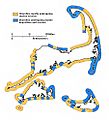Deposition (geology) facts for kids
Deposition is the geological process where material is added to a land (or a landform). This can happen in many places, such as a beach or river. Some parts of a shoreline build up and grow out, whereas other parts of the shoreline erode and fall into the sea.
In deposition, wind and water lay down grains of material that have been eroded and transported from another place. Deposition happens when the forces which transport sediments are weaker than the forces of particle weight and friction. This causes a resistance to movement, and the particles drop down.
Deposition can also refer to the buildup of sediment from organically derived matter or chemical process.
Related pages
Images for kids
-
Map of Cape Cod showing shores undergoing erosion (cliffed sections) in yellow, and shores characterized by marine deposition (barriers) in blue.
-
Figure 1. Illustrating the sediment size distribution over a shoreline profile, where finer sediments are transported away from high energy environments and settle out of suspension, or deposit in calmer environments. Coarse sediments are maintained in the upper shoreline profile and are sorted by the wave-generated hydraulic regime
See also
 In Spanish: Deposición (geología) para niños
In Spanish: Deposición (geología) para niños



